Denny O’Neil has shaped modern Batman more than any other creator. And while he consciously sought to put the ‘dark’ in ‘Dark Knight,’ part of what makes his output so appealing is the fact that the ‘knight’ side is usually there as well – O’Neil’s Batman is well-travelled, chivalrous, brave, and certainly not above some good old fashioned swordplay:
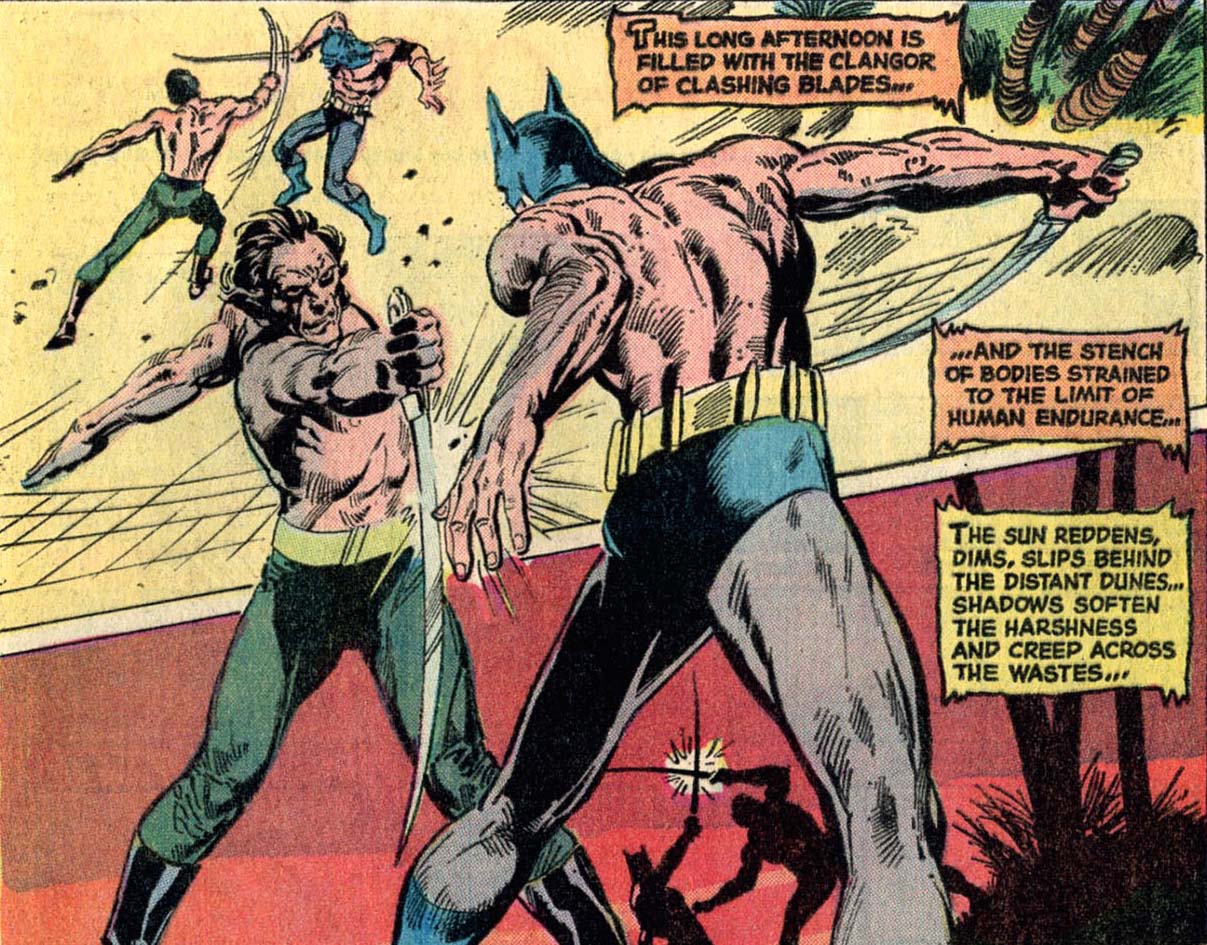 Batman #244
Batman #244
Take O’Neil’s first issues, in the early 1970s. These featured mostly done-in-one solo stories (sans Robin) that unapologetically embraced the pulpy conventions of the material. Most of them were adventure yarns in which Bruce Wayne would roam the world with the bat-cowl in his suitcase (and no one ever found it suspicious that he and Batman would always show up in the same places). More than a strong-willed powerhouse, the Caped Crusader was depicted as a deductive genius and master of disguise, although still fallibly human. Villains would leave him to die in an elaborate deathtrap rather than simply kill him and Batman would inevitably escape through a clever loophole in the trap.
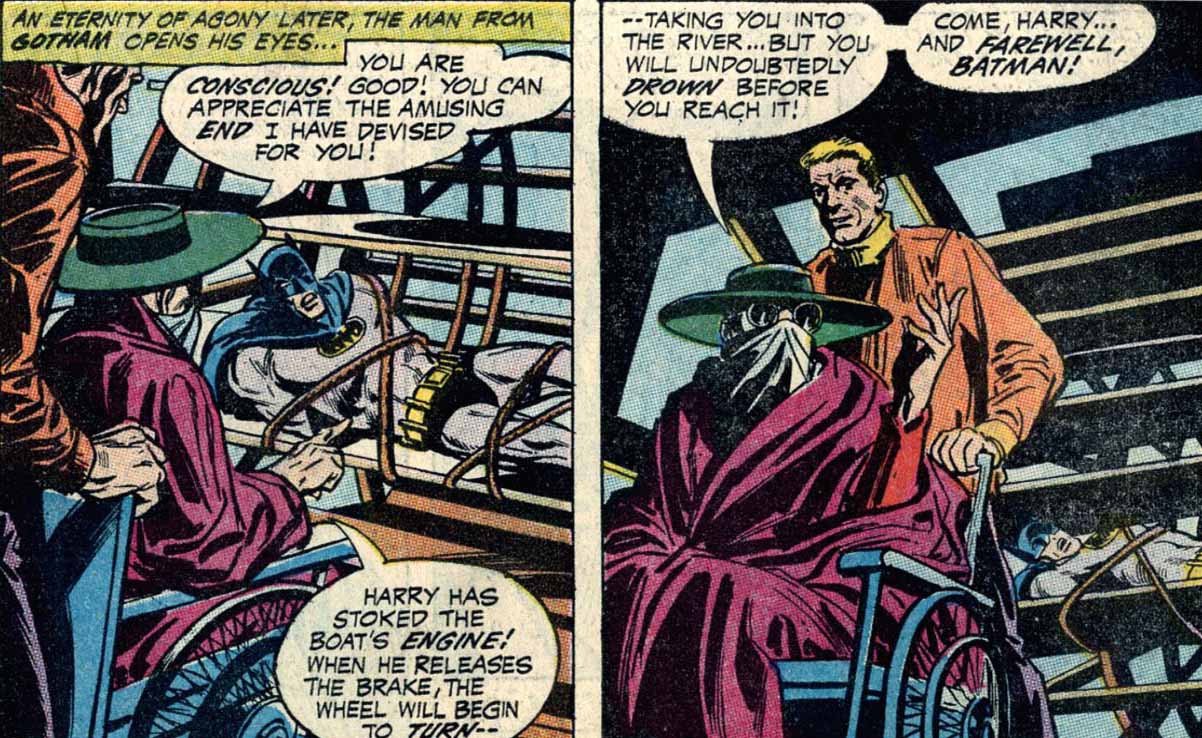 Batman #224
Batman #224
Taking advantage of Neal Adams’ and Irv Novick’s atmospheric pencils, beautifully inked by Dick Giordano, Denny O’Neil’s earlier tales were unabashedly gothic and full of over-the-top purple prose. His debut story, ‘The Secret of the Waiting Graves,’ starts by asking readers to ‘Stand still and hear the wind howling like souls in torment… see the rise of an ashen moon… breathe deeply and sniff the scent of death…’ Given the prowess of the artists working on these comics, O’Neil’s narrative captions are mostly unnecessary in terms of storytelling, but his poetic flights of fancy help create a genuinely eerie mood. ‘Legend of the Key Hook Lighthouse!’ even kicks off in verse:
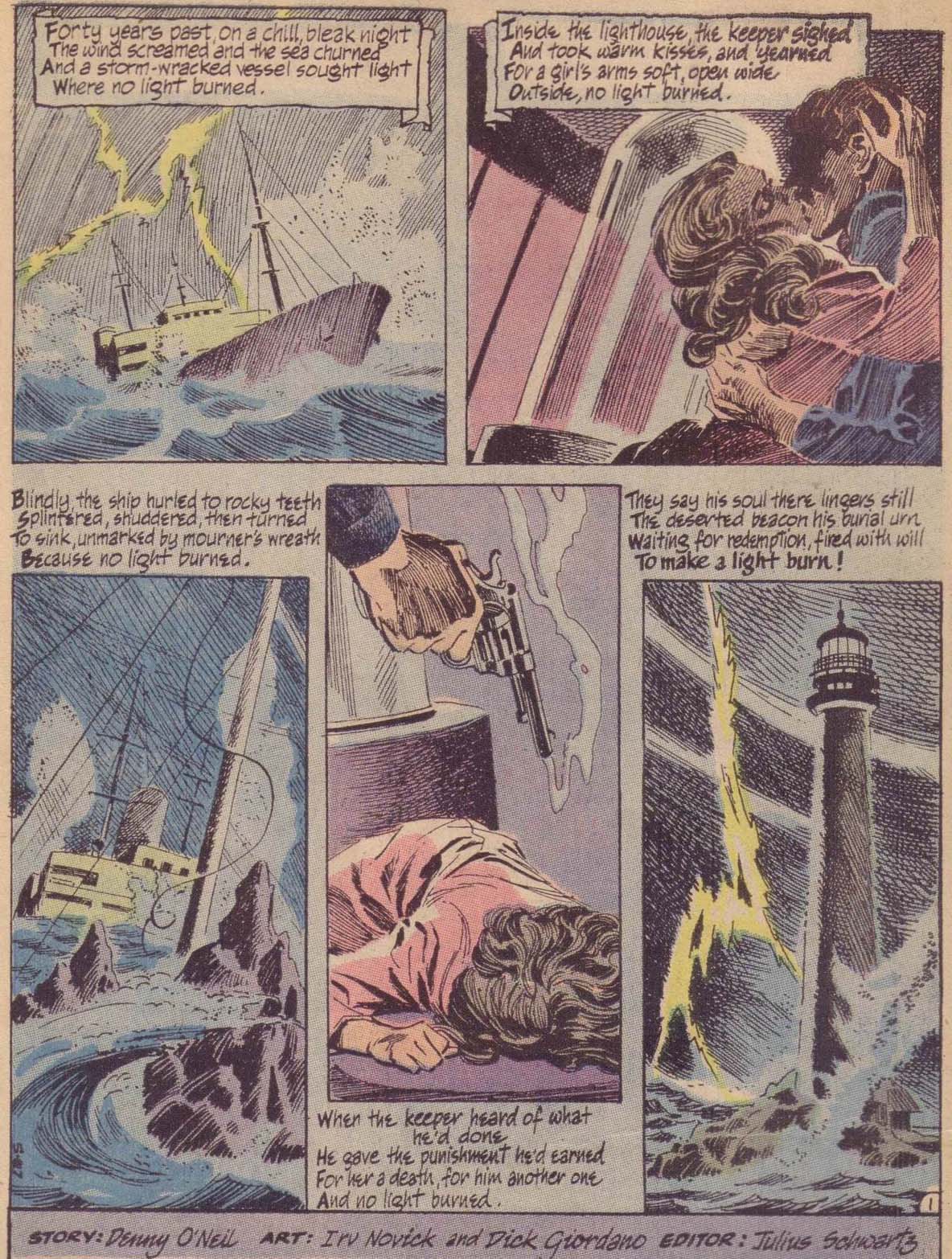 Detective Comics #414
Detective Comics #414
O’Neil would later take his literary affectations to the extreme in the brilliant ‘Death Strikes at Midnight and Three,’ which is part dense prose, part experimental montage, and 100% hardboiled goodness:
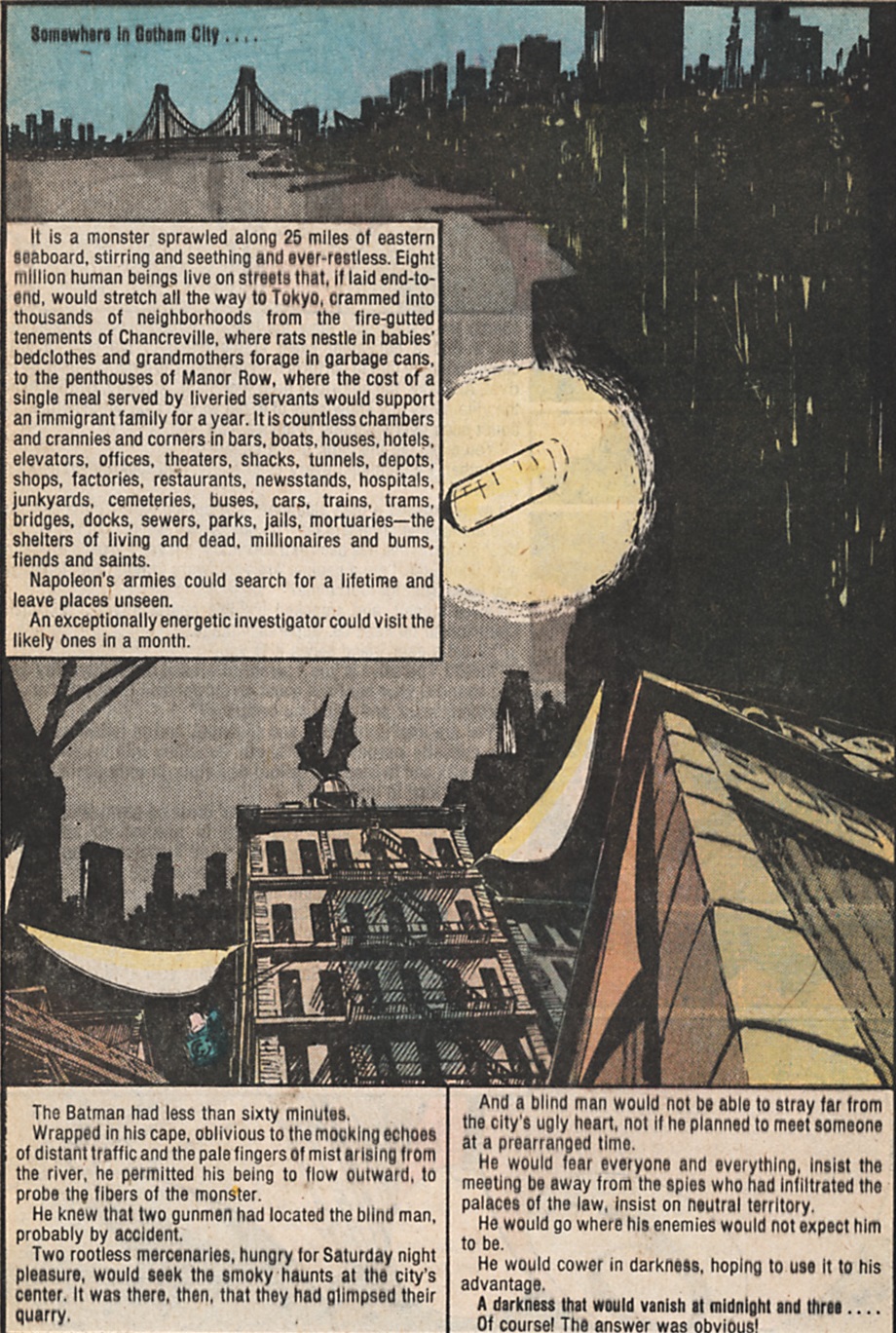 DC Special Series #15
DC Special Series #15
Denny O’Neill was also great at murder mysteries, which is no small feat when you have around 15 pages to set up the crime, introduce the cast of suspects, and throw in enough red herrings to make it challenging. What’s more, as these were fair play mysteries, his comics often included a neat panel directly daring the reader to spot the necessary clue to solve the puzzle.
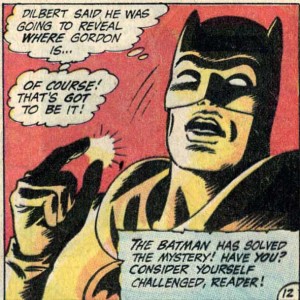 Detective Comics #399
Detective Comics #399
No tale combines all these trademarks as powerfully as the classic ‘Ghost of the Killer Skies!’ which features a foreign setting (Spain), a gratuitous yet exciting death-defying challenge that Batman has to overcome through ingenuity (air battle between vintage aircraft), elaborate prose adorning Neal Adams’ majestic drawings (‘Leave now the eyes of the dread Batman and follow the caped avenger through a tangle of crime and into the bleakest corner of a man’s soul…’), and an intriguing whodunit premise (a pilot strangled in mid-air, in a single-seater plane). Throw in an anti-war message and the ghost of Enemy Ace – the German WWI pilot of the amazing war comics by Robert Kanigher and Joe Kubert – and you’ve got one hell of a story in your hands!
As if all this was not enough to ensure Denny O’Neil a firm place in Bat-history, he created two of the most fascinating characters in the Batman cast – love interest Talia al Ghul and her father, the megalomaniac, repeatedly resuscitated, eco-terrorist Ra’s al Ghul. Most of these comics, reprinted in the Tales of the Demon collection, have become so engrained in the imagination of Bat-fans that it is easy to miss the slow-burn build-up of the original saga… At first sticking to the formula of done-in-one stories, O’Neil kept revealing new layers and gradually escalating the stakes until what started as typical Batman mini-adventures culminated in arguably the most memorable showdown of the Caped Crusader’s career.
In the otherwise forgettable Detective Comics #405, Batman bodyguards a shipping magnate by facing kamikaze dolphins (where do you think the Soviets got the idea from?) and a martial arts killer, only to realize that his opponent belongs to a much vaster League of Assassins. In the following issue, the Dark Knight has his first confrontation with the League’s president, Ebenezer Darrk – despite the villain’s uninspired name, this is a nice little tale of secret passages, medieval traps, double-crosses, and last-minute escapes. Also, it opens with a bang:
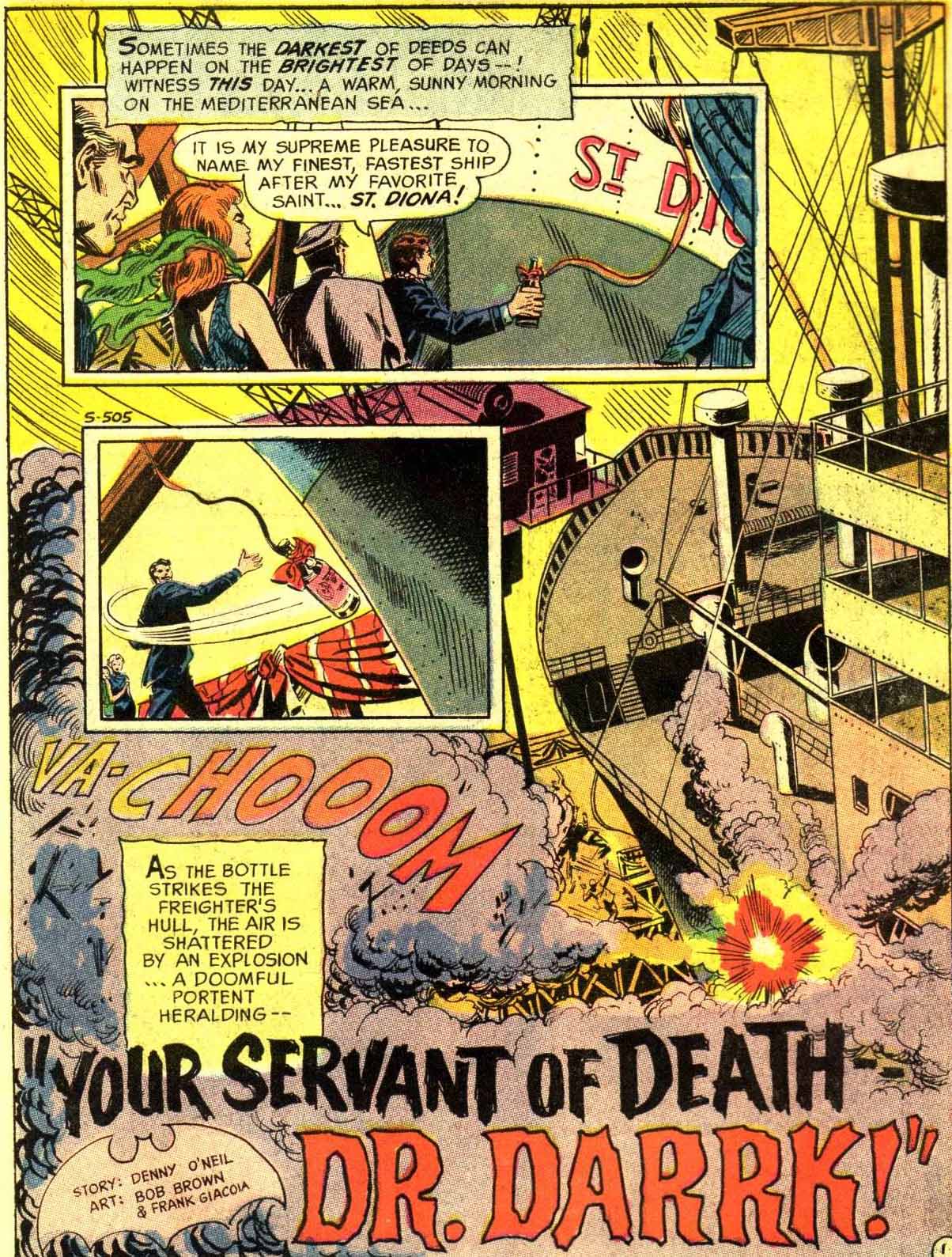 Detective Comics #406
Detective Comics #406
Detective Comics #408, scripted by Len Wein (with an even more gothic voice than O’Neil’s), is tangentially related to the Masked Manhunter’s feud with the League of Assassins, without adding much to the overall saga. Neal Adams draws some breathtaking hallucinations, but reading the issue means stomaching one of Batman’s most racialized foes, namely the Fu Manchu-inspired Dr. Tzin-Tzin (whose only redeeming quality as a character is that a few years later he stole all knowledge of Christmas from Gotham City, which even for Gotham standards is a pretty eccentric heist).
Dr. Darrk meets his demise in Detective Comics #411 – yet instead of bringing closure to the story arc, this instalment hints at an even more complex web of international intrigue. Readers meet Talia al Ghul, whose father had a falling out with Darrk ‘over some sort of business.’ We are definitely in grand adventure territory here. Accepting the genre’s inherent orientalism, O’Neil combined different cultures with gusto in order to provide an out-of-this-world sense of exotic excitement: the tale takes place in an unidentified Far East country (‘a tiny Asian nation tucked into the mountains between two hostile super-powers’); we are told Ra’s al Ghul is Arabic for ‘The Demon’s Head;’ a plot point involves arms deals in South America; and in a great sequence Batman literally has to bullfight for his life. O’Neil followed this with Batman #232, where the Caped Crusader wrestles a leopard in Calcutta and climbs one of the Himalayan Mountains, under fire. The stakes feel higher than usual – Robin gets shot in the very first page and Ra’s al Ghul makes his entrance by revealing that he has figured out Batman’s secret identity.
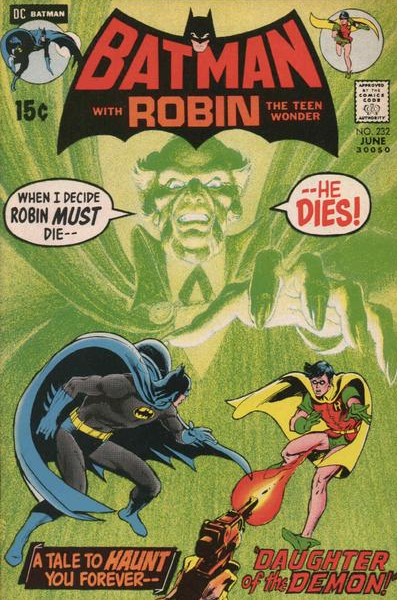 The big picture continues to unfold, as we are introduced to Ubu and to the Brotherhood of the Demon. Ra’s is not even revealed as the villain until the end… and even then his motivation appears to be a melancholic wish to retire and to satisfy his daughter’s infatuation with Bruce. Indeed, in Batman #235 and Batman #240 the Dark Knight is still willing to trust and even partner up with Ra’s and Talia, whom he apparently doesn’t yet consider all that evil… although the al Ghuls’ decision to remove the brain of the director of a think tank in order to extract confidential information about the Vietnam War finally changes that.
The big picture continues to unfold, as we are introduced to Ubu and to the Brotherhood of the Demon. Ra’s is not even revealed as the villain until the end… and even then his motivation appears to be a melancholic wish to retire and to satisfy his daughter’s infatuation with Bruce. Indeed, in Batman #235 and Batman #240 the Dark Knight is still willing to trust and even partner up with Ra’s and Talia, whom he apparently doesn’t yet consider all that evil… although the al Ghuls’ decision to remove the brain of the director of a think tank in order to extract confidential information about the Vietnam War finally changes that.
It’s with Batman #242 that the narrative picks up speed, turning into a no-holds-barred rollercoaster ride. Batman fakes Bruce Wayne’s death on the first page. By page 5, the Dark Knight himself is apparently murdered. We are introduced to Matches Malone, who will remain Bruce’s moustachioed slimy crook alter-ego for the following decades. There is a plot twist on every page as Batman rounds up a ragtag team (‘a reluctant scientist, a superstitious bandit, and a dead gangster’) to wage war against Ra’s al Ghul and his hordes of trained soldiers. By Batman #243 we’re in full-on James Bond mode, with a dynamic martial arts combat, proto-Bond girl Molly Post (who sadly only reappeared one more time, in Detective Comics #451), and henchmen getting knocked out all over the place as the heroes make their way to the villain’s lair in the Swiss Alps. This is also the issue in which we learn that a dead Ra’s al Ghul can be brought back to life by being dipped in the magical Lazarus pit. The whole thing climaxes in Batman #244, where the Caped Crusader chases a hovercraft on a pair of skis, duels Ra’s under the burning desert sun, gets poisoned by a deadly scorpion, passionately kisses Talia, and saves the world, although not before bursting into one of the most iconic Batman panels of all time in all his hairy chest glory:
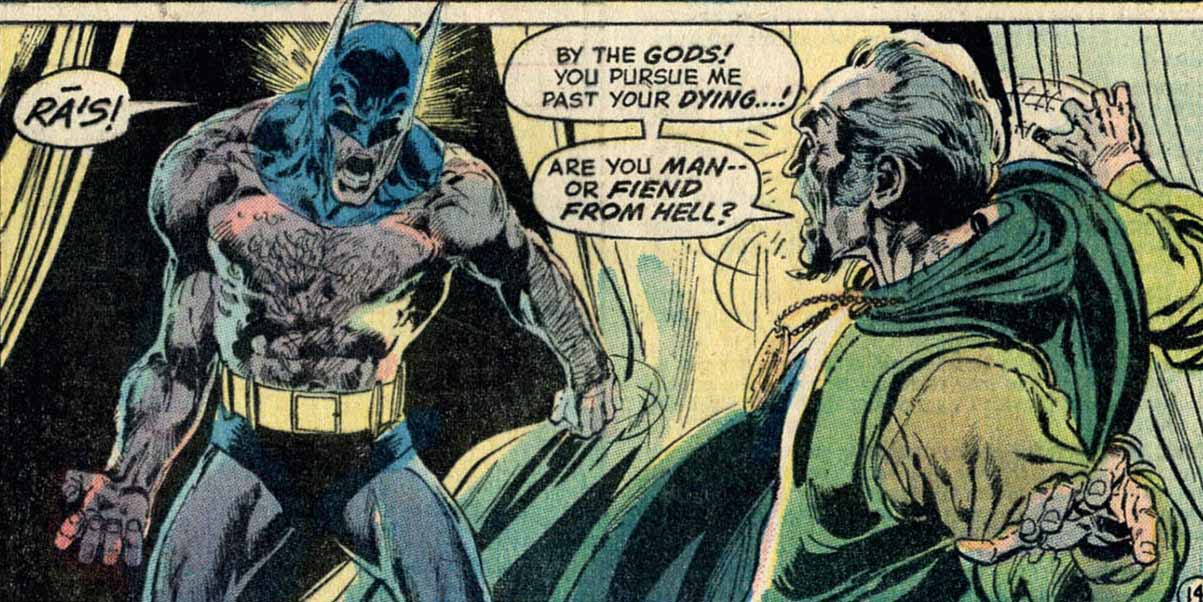 Batman #244
Batman #244
Batman #245 serves as an epilogue, wrapping up the Bruce-Wayne-is-dead plot thread. It is dated October 1972, two years after the saga first started on the pages of Detective Comics.
After this globetrotting extravaganza, Denny O’Neil’s Batman stories grew increasingly urban, most famously in ‘There is No Hope in Crime Alley!’ where O’Neil established the place where Bruce Wayne’s parents were killed – Park Row, now known as Crime Alley. He also created the character of Leslie Thompkins, the kind old woman who represents all that’s worth saving in Gotham City and who became a recurrent character in the Dark Knight universe.
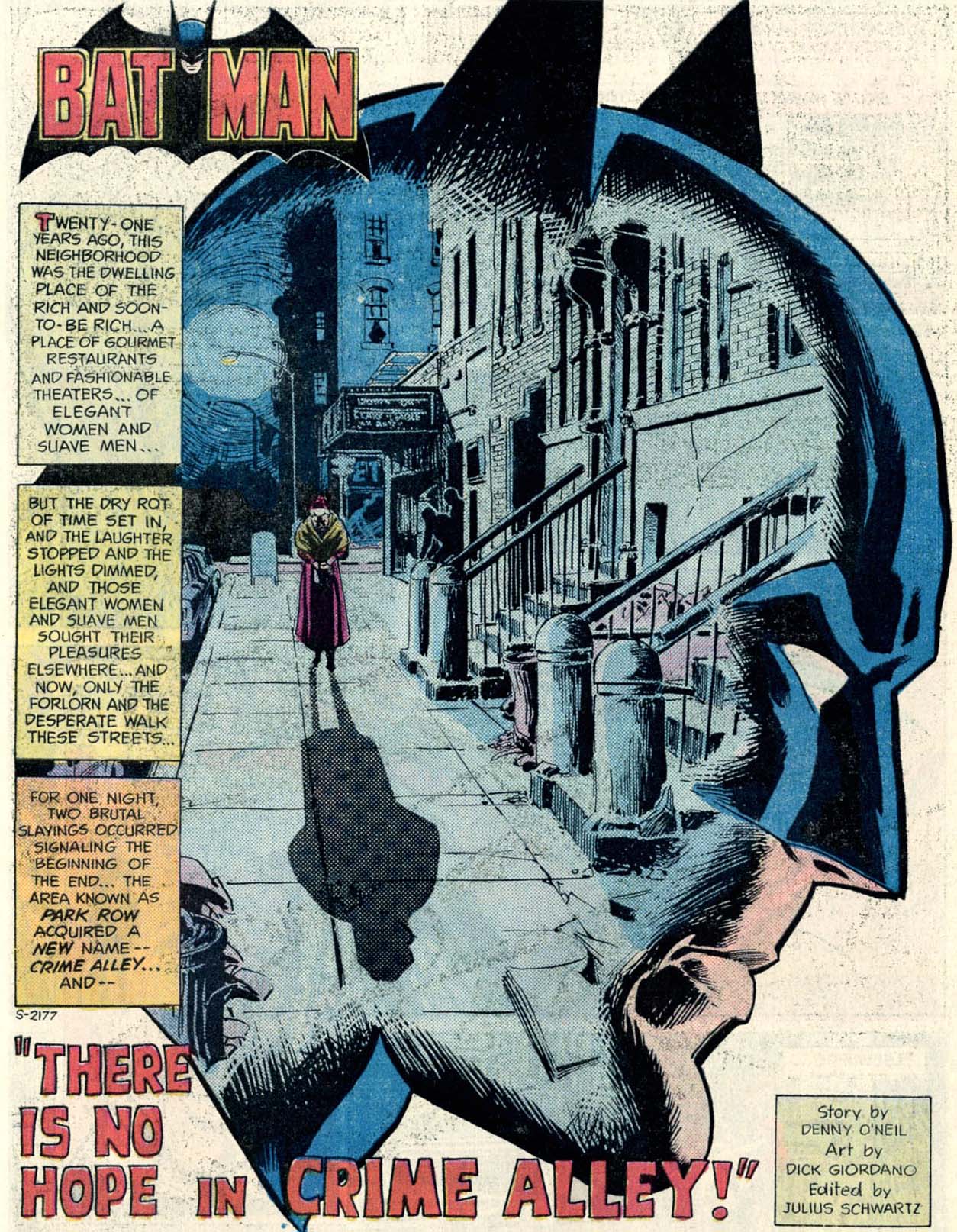 Detective Comics #457
Detective Comics #457
The comic became such an instant classic that the sequel, written 3 years later, directly echoed its beginning:
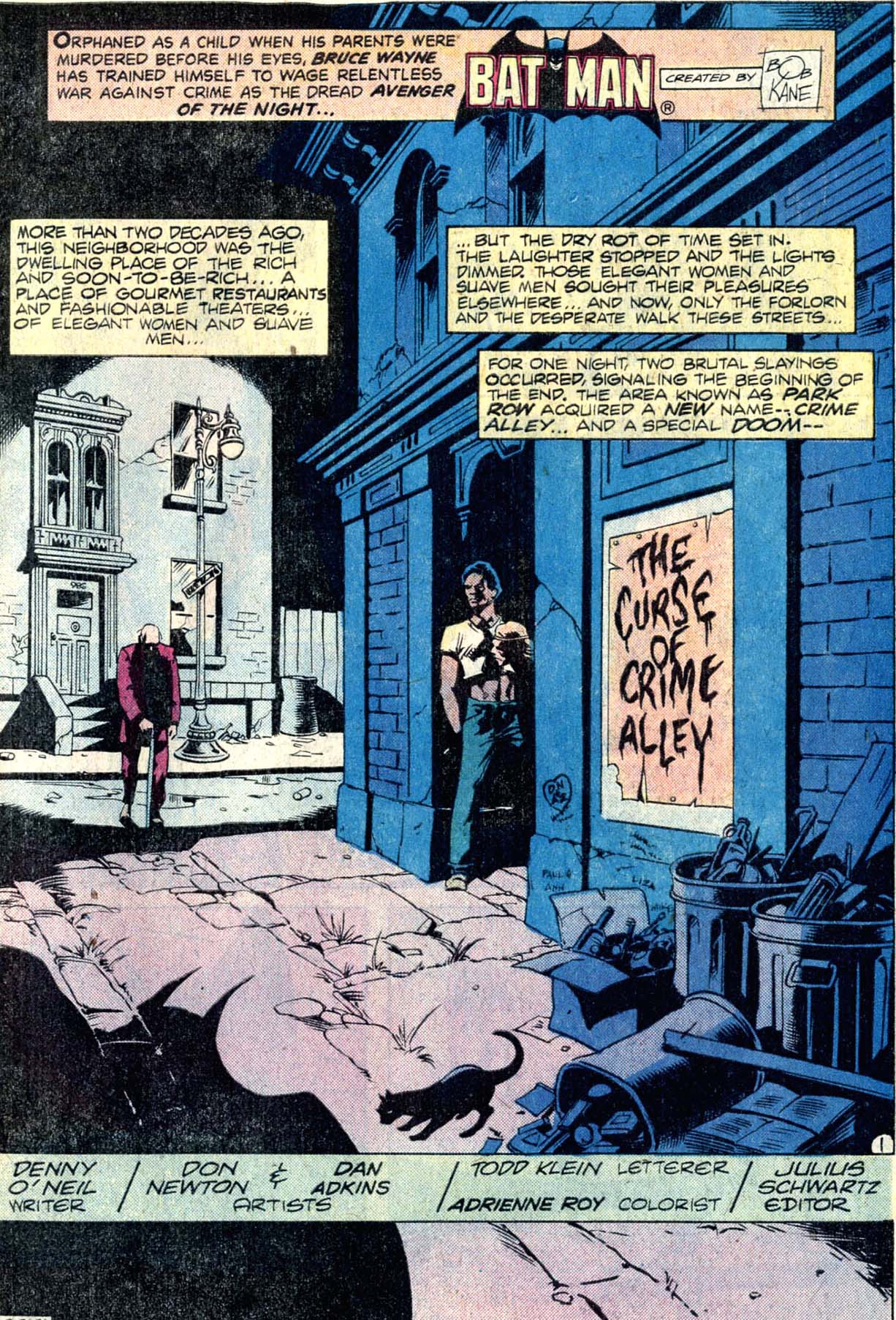 Detective Comics #483
Detective Comics #483
These are cornerstone Batman comics, which not only heavily inspired Mike W. Barr but also the awesome Batman: The Animated Series episode ‘Appointment in Crime Alley.’ The latter of these issues also marks the debut of Maxie Zeus, the crime boss who swears to anyone who’ll listen that he is an actual Greek god.
Besides introducing new elements into the Batman mythos, Denny O’Neil did a great job of breathing life into old villains who hadn’t been seen for years. Out of all the classic rogues he brought back, O’Neil’s most lasting update concerned the Clown Prince of Crime:
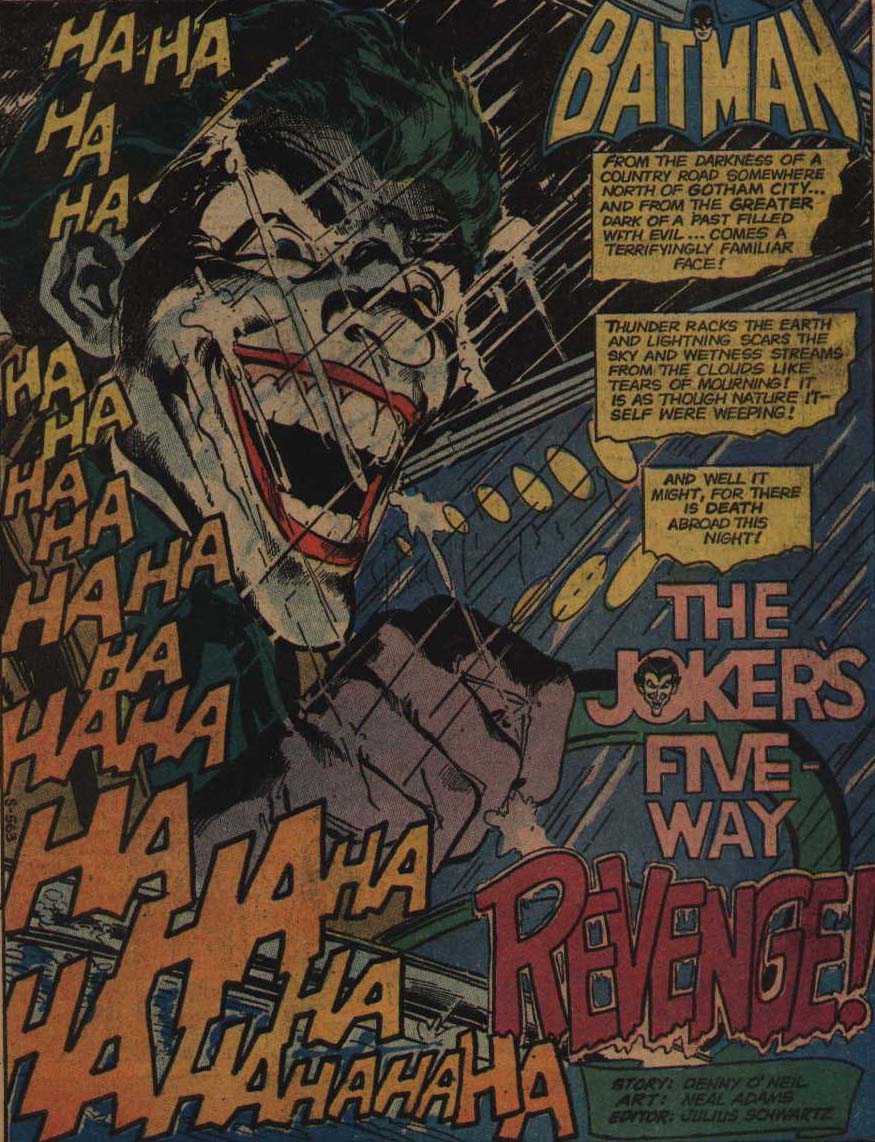 Batman #251
Batman #251
After three decades of being depicted as little more than a wacky prankster, under O’Neil the Joker returned to his roots as a sadistic murderer. His take on this rogue proved so popular that O’Neil even spun it into its own series, where the Joker faced off against other characters.
 This series started out strongly by pitting the demented antics of the Joker against Two-Face’s own brand of twisted logic, but soon lost its footing… although in The Joker #6 O’Neil did write a particularly fun story entirely based around Sherlock Holmes references.
This series started out strongly by pitting the demented antics of the Joker against Two-Face’s own brand of twisted logic, but soon lost its footing… although in The Joker #6 O’Neil did write a particularly fun story entirely based around Sherlock Holmes references.
Denny O’Neil would continue to write Batman comics for years. He tried his hands at different kinds of stories, including a couple of Unsolved Cases of the Batman, where he challenged himself to write tales in which the Dark Knight would fail while still providing a satisfying resolution (he came closest with ‘The Galileo Solution’). O’Neil also returned to the al Ghul clan quite a few times – under his scripts, Talia married Bruce against his will (‘I Now Pronounce You Batman and Wife!’); Ra’s had the original Batwoman killed off as part of a plan to take over the League of Assassins (‘The Vengeance Vow’); Batman and Ra’s teamed up first to prevent the Earth from turning into crystal (‘The Crystal Armageddon’) and then to keep the Sensei from assassinating the world’s religious leaders for purely artistic reasons (‘Requiem for a Martyr!’); Talia and Batman had a bittersweet reunion (‘The Monkey Trap’); and we were finally given a close look at Ra’s origin (‘Birth of the Demon’). Oh, right, and the al Ghul family also hung out with the Batman-wannabe hero Azrael a bunch of times, even helping him discover that he was a motherless test tube baby whose genes had been spliced with those of various animals (‘Fallen Angel’). Bummer.
O’Neil’s other massive contribution to the Batman universe may not be as evident at first sight. I’m talking about his phenomenal series The Question:
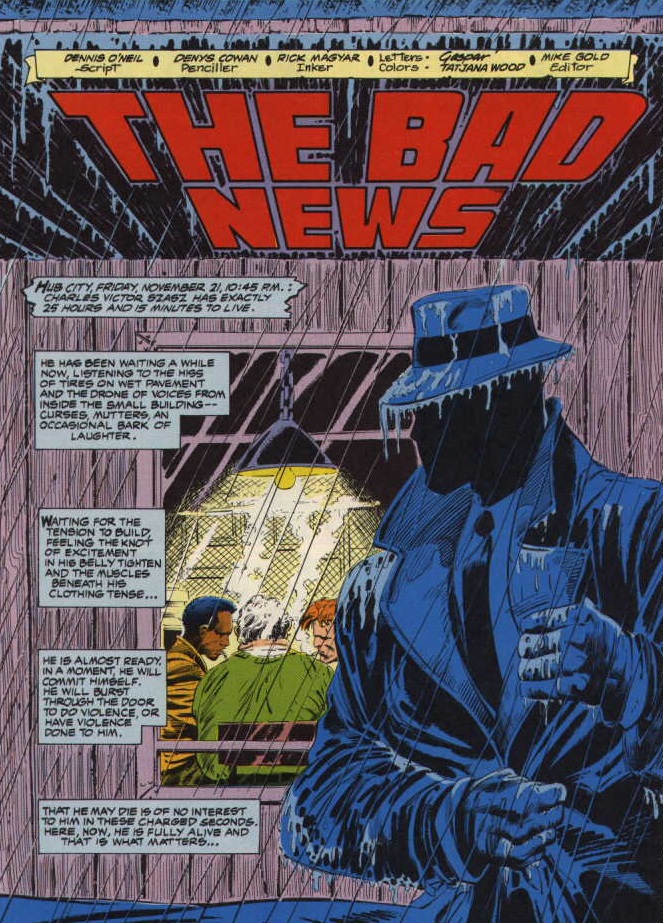 The Question #1
The Question #1
This was one of those runs, so in vogue in the ’80s and ’90s, where the author shockingly killed off an established protagonist on the very first issue in order to completely reinvent the character. Although not as extreme a revamp as Alan Moore’s Swamp Thing, Neil Gaiman’s Black Orchid, or James Robinson’s Starman, O’Neil nevertheless had the objectivist vigilante known as the Question (Vic Sage) practically beaten to death, shot in the head with a pellet gun, and thrown into the river, only for him to come back as a Zen martial arts expert who fought against villains of different philosophies.
The series was not set in Gotham, but in Hub City – which somehow managed to be even more corrupt and decadent, run as it initially was by a crazy reverend and an alcoholic mayor. Yet there were key links to the Batman universe: the Dark Knight had a cameo early on and the two heroes soon teamed up (it was the Question who set up Batman’s first encounter with the cult character Lady Shiva); the series introduced Santa Prisca, birthplace of the villain Bane, as well as the mute Harold Allnut, who became a regular assistant in the Batcave. And in an inspired move, the Question fought the Riddler… and won by asking him about life’s greatest mysteries!
The Question and his supporting characters would later show up in various Batman-related comics, most notably in those starring Azrael and the Huntress. Furthermore, when Vic Sage died of cancer in 2006, fan-favorite ex-Gotham City cop Renee Montoya took over his legacy.
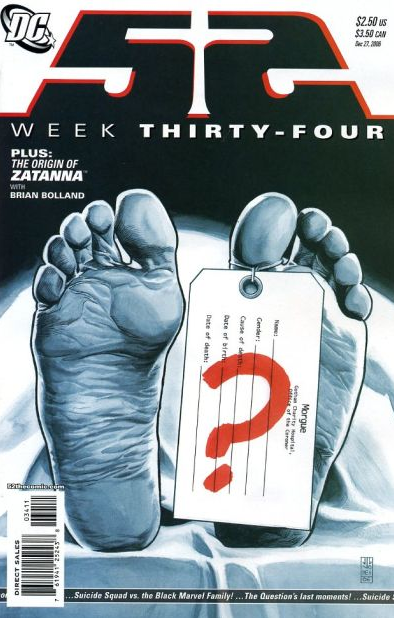 The Question’s biggest impact on Batman, though, was arguably more subtle. Its twisted crime stories and the proto-noir mood evocative of Will Eisner’s The Spirit (which, for those of you not in the know, is the highest compliment you can pay to a comic) seem to have hugely influenced a whole generation of writers. I wonder how many of the sickest Batman tales in the last decades were a product of the trauma inflicted by this page:
The Question’s biggest impact on Batman, though, was arguably more subtle. Its twisted crime stories and the proto-noir mood evocative of Will Eisner’s The Spirit (which, for those of you not in the know, is the highest compliment you can pay to a comic) seem to have hugely influenced a whole generation of writers. I wonder how many of the sickest Batman tales in the last decades were a product of the trauma inflicted by this page:
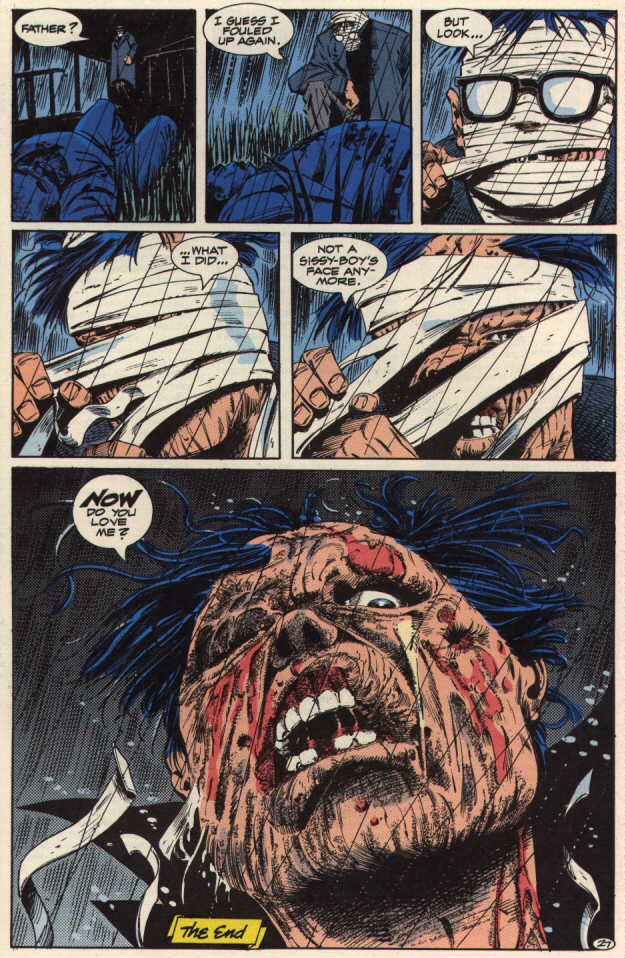 The Question #6
The Question #6
Regardless, as writer alone – which is to say, even disregarding his decisive role as group editor for Batman’s various titles from 1986 to 2000 – Denny O’Neil was responsible for some of the coolest stories and characters in the Dark Knight universe. This, my friends, is why we owe it to O’Neil to collectively forget that he also wrote over a hundred god-awful comics about the aforementioned delusional, genetically engineered human-animal hybrid killer brainwashed by a secret religious society, so-1990s-it-hurts, Azrael:


Too many people näively call Frank Miller the writer who “saved” Batmanfrom campiness; however, this is like someone telling me Columbus discovered America. Dennis O’Neil was THE guy who returned Batman to his dark and grim roots from the golden age, combined with his silver age traits, as well as becoming a psychologically rich hero. Denny’s Batman was a Batman who embraced his trauma, yet remains above it, aids his teammates and had a complicated love history. Without Denny (both as writer and editor), nothing about the character, including TDKR, Batman: TAS and Christopher Nolan’s Dark Knight trilogy, would have been possible.
O’Neil ‘s hit one, miss one– like almost all comix writers. It’s the nature of a periodical industry. (The only BATMAN writers who hit for high percentage are probably Archie Goodwin, Steve Englehart and Alan Brennert, and they didn’t write that many.) But O’Neil ‘s “Batman” is one of the definitive versions. When he was on, he was ON. Only Finger and Englehart understand Batman as clearly as O’Neil.